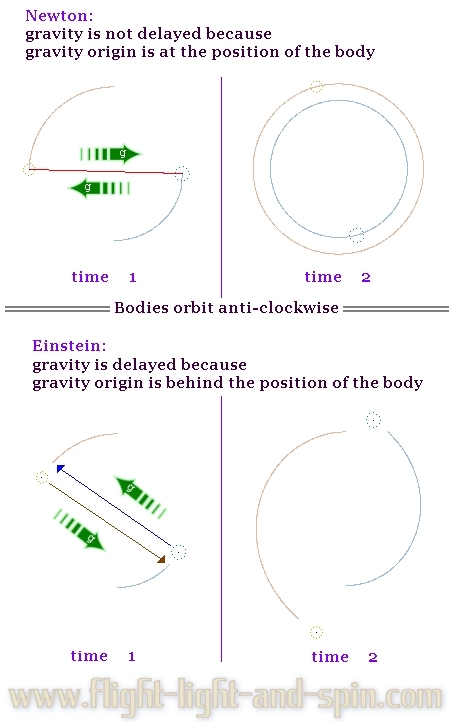All
the geometry within this article evolved in computer algorithm. The
software used is orbit-gravity-sim-11.exe
which is free to download. The program demonstrates the evolution of
binary-orbits in real-time under a variety of gravity theories. Consider a pair of equal-mass binary stars. Ponder how the velocity of gravity will affect the shape of these orbits. First consider gravity to be instant as Newton theorized; then consider it to travel at the velocity of light as Einstein proposed. Surely it is crystal clear that these two different theories will not yield the same result? . |
||
 |
||
If
gravity travels instantly then it must pull at an angle precisely perpendicular
to the orbit-line directly across the midpoint. But if gravity travels
at the velocity of light then it would pull to the position where the
opposing star was when the gravity departed from that star. The gravity
must first travel the distance between them before it can pull on the
opposing body. This will affect the shape of the binary orbit. . |
||
 |
||
If
gravity travels at the velocity of light then binary star-systems will
spiral outwards away from each other. Because
most stars form binary pairs, gravity must be propagated instantly in
order to ensure that binary orbits persist for many billions of years
as they are commonly observed to do. The rate of outwards spiral depends
on their velocity and distance apart. The binary pair in the next graphic have slightly different mass to each other. They evolved strictly under algorithm orbit-gravity-sim-11.exe. This clearly shows that if gravity travels at the velocity of light then the force must pull to a point away from the midpoint (barycenter) of the binary pair. . |
||
 |
||
Note
the gap between the orbit-line and the body. This designates that the
origin of the force of gravity is not the same as the position of the
body. However, the famous LIGO experiments postulate that a binary pair supposedly spiral inwards if gravity moves at the velocity of light. So let us use more detail so that we can establish by how much a binary pair would spiral outwards if gravity travels at the velocity of light. At about 2500km apart, a binary pair of equal mass (both 33 solar masses) with an almost circular orbital-shape travels at roughly one-tenth the velocity of light. So the delay in gravity causes a divergence between the gravity origin and the body itself of about one-tenth the distance between them. There is thus a gap of about 250 km between where the body actually is and where it was when it generated the gravity that eventually reaches the opposing body. Because the bodies travel at 1/10th the velocity of light, the gap between the body and the gravity origin is about 1/10 of the distance between the pair of bodies. That
is a very big gap, proportionally speaking. So
we can see what this looks like with more accurate information. These
graphs evolved in orbit-gravity-sim-11.exe with
gravity moving at the velocity of light with data similar to the famous
LIGO binary pair GW150914. |
||
 |
||
The
binary pair spiral outwards so rapidly, that it is easy to see how
they could never have started out that close together in the first
place. It would not be possible for a pair of 'black-holes' to reach
an orbit as close as 2000km apart as the LIGO theorists suggest -
if gravity travels at the velocity of light. The next graph is the
same example as above but progressed further in time. |
||
 |
||
Perhaps
that data is a not quite down to Earth enough for you? |
||
 |
||
After
20 000 orbits the binary pair of one solar mass each would be spiralling
away from each other by more than a million km per orbit - if gravity
travels at the velocity of light. And that amount would be increasing
by well over 50km for every orbit. This concept has been termed BOGVOS:
Binary-Orbit, Gravity-Velocity, Out-Spiral.
Jonathan Ainsley Bain |
||
 |
 |
 |
| Other
topics in this series of short articles: |
||
The quickest
mind always entertains every logical possibility.
^ top of page ^
